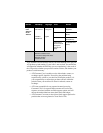27
memory can only encode to either “0” or “1.” So a graphical bit depth of 1
means that the display can only show two colors, the black and white of a
monochrome display. Four-bit color depth is capable of displaying 16
colors because there are only 16 different combinations of 4 bits (“0000”,
“0001”, “0010”... to “1111”). Sixteen-bit color is capable of reproducing
65,536 colors, and 24-bit color can display up to 16,777,216 individual
colors.
Bitmap
A bitmap is a graphic or character representation composed of individual
pixels, arranged horizontally in rows. A monochrome bitmap uses one bit
per pixel (bpp). Color bitmaps may use up to 32bpp, depending on the color
depth selected.
Brightness
The amount of white or black that is applied to all colors onscreen. By
making the screen “brighter” you are adding more white to it. This should
not be confused with luminosity, which measures the actual light level
emitted from the computer display.
Buffer
A name referring to portions of on-board video memory. One large buffer
is always used to display images to the screen; this is the “display buffer.”
The rest of offscreen memory is typically used by applications as back
buffers, z-buffers, and texture buffers.
Charisma Engine™ II
Incorporating a programmable Vertex Shader pipeline, Charisma Engine™
II is a transform and lighting engine designed to make 3D characters and
transitions even more life-like.
Color Component
Three color components—Red, Green, and Blue—combine in various
intensities to determine the color of each pixel on the screen. The values of
each color component are graphically represented by a corresponding color
curve.


















